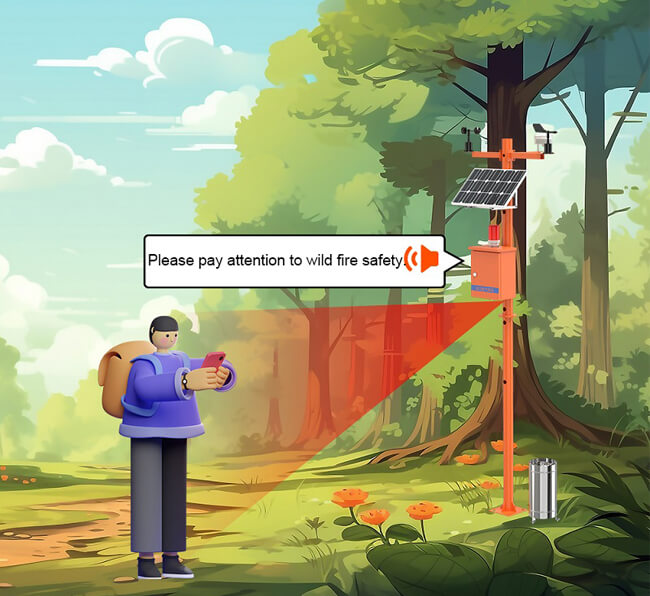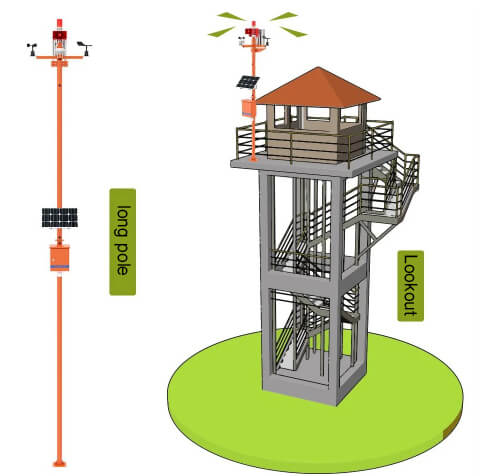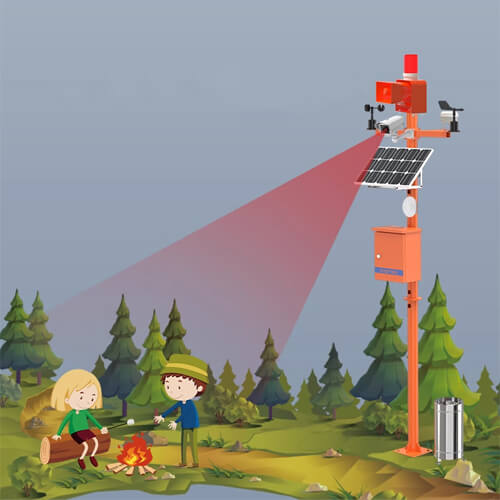In the dry season of fall and winter, dead wood and fallen leaves in forests can easily generate wildfires under lightning or human factors, which can quickly develop into forest fires if not extinguished in time. Forest fire is the most dangerous enemy of forests and the most terrible disaster of forestry, which will bring devastating consequences to forests. Forest fires not only burn down patches of forest and harm the animals in the forest, but also reduce the reproductive capacity of the forest. Fires can cause soil infertility and destroy forest water sources, and can even lead to a loss of ecological balance. Therefore, to prevent forest fires, it is necessary to install forest fire weather stations in key areas.
What is a wildfire?
Wildfires are uncontrollable fires in natural areas caused by lightning or human factors. Wildfires include forest fires, brush fires and peatland fires.
Forest fires are fires that occur in areas covered with natural vegetation such as forests, grasslands and woodlands. Forest fires can be categorized into two types: natural fires and man-made fires. Natural fires are usually started by weather factors such as lightning strikes, drought, and high temperatures, while man-made fires are started by careless human handling, burning of garbage, smoking, etc.
Recent Big Forest Fire Video from @PBSNewsHour
What causes a wildfire?
It is estimated that nearly 85% of the world’s wildfires are caused by human activity. Fires can be accidentally started by campfires for wild warmth, unextinguished burning debris, the use of incendiary devices, and the indiscriminate disposal of cigarettes. Intentional arson is another source of man-made wildfires.
Natural causes of wildfires are lightning and volcanic activity, with lightning strikes being a more common catalyst. Most often, lightning strikes a tree and starts a fire. In addition strong hurricane winds can blow down power lines, which can start a wildfire if there is dry brush or grass around. Wildfires can quickly develop into fires in dry and windy weather conditions.2023 Forest fires in Canada and across North America are very serious because of the persistence of warm and dry weather, while climate change has led to many areas experiencing record heat and drought.
How to prevent froest fire?
1. For some unconscious perceived activities, people’s awareness can be raised by conducting forest fire prevention education. For example, campfires and burning debris should be disposed of in a timely manner when camping in the wild, cigarettes should not be thrown away, and principle bushes should be used when using combustion equipment.
2. It is very important to detect and take active measures in time for fires caused by intentional arson and other natural causes. With the help of forest fire weather stations to monitor different locations in the forest in real time, as soon as a fire is detected immediately notify the forest protection personnel.

Composition of forest fire weather stations
The forest fire weather station consists of meteorological sensors, microcomputer meteorological data collector, power supply system, solar radiation shield, field protection box and stainless steel bracket. The wind speed sensor and wind direction sensor provide data support for the fire situation and direction. The microcomputerized weather data collector collects data from all weather sensors and provides data storage and transmission. The protective case protects the sensors from extreme weather and animal damage and extends the service life of the sensors. Stainless steel bracket stably supports the sensor and collector work, also waterproof and fireproof.
The complete forest weather station can automatically monitor the wind direction, wind speed, air temperature, humidity, rainfall, etc., and regularly transmit the on-site weather and image parameters to the fire command center. It automatically calculates the forest fire risk level at that time and sends panoramic video images of the scene at the same time, so as to do remote lookout, monitor the initial fire point in time and provide scientific basis for fire prevention decision-making.
Complete Forest Weather Station Monitoring Parameters
| Elements | Measurement Range | Resolution | Accuracy |
|---|---|---|---|
| Air Temperature | -40~60℃ | 0.1℃ | ±0.2°C(25°C) |
| Air Humidity | 0~100%RH | 0.1%RH | ±0.2%RH(60%,25°C) |
| Atmospheric Pressure | 0~120Kpa | 0.1Kpa | ±0.15Kpa |
| Wind Speed | 0~70m/s | 0.1m/s | ±0.3m/s |
| Wind Direction | 8 Directions | 1 Direction | / |
| Noise | 30~120dB | 1dB | ±0.5dB |
| Rainfall | 0~8mm/min | 0.2mm | ±2% |
| Total Radiation | 0~1800w/m2 | 1w/m2 | / |
| Negative Oxygen Ion | 0~5 million/cm3 | 10/cm3 | ±15% |
| Oxygen | 0~25%Vol | 0.1%Vol | ±2%FS |
| PM2.5 | 0~1000μg/m3 | 1μg/m3 | ±10% |
| PM10 | 0~1000μg/m3 | 1μg/m3 | ±10% |
| Illumination | 0~200,000 Lux | / | ±7%(25℃) |
| Rain and Snow | Yes/No | / | / |
| Ultraviolet | 0~450μW/cm2 | 1μW/cm2 | ±10%FS |
In addition to the above necessary monitoring elements, monitoring of atmospheric pressure, solar radiation, soil temperature, soil moisture, etc. can be added. With smoke sensors and gas sensors to monitor whether there is a lot of smoke around due to combustion. Temperature sensors are utilized to measure the surrounding temperature to determine if a fire is occurring. With the function of timely alarm when abnormal values are detected by these sensors, measures can be taken at the first opportunity. However, there are limitations to this approach, which is more suitable for forest areas with a small area and easy to fight fires, so we need to match sensors according to the usage scenarios when choosing sensors.
- Smoke Alarm: Fire prevention by monitoring the concentration of smoke.
- Temperature Sensor: To judge whether fire occurs by monitoring the change of temperature.
- Gas Sensor: The gases produced by combustion, such as CO, CO2, CH4, H2, can be used as the basis for fire detection.
In large forests, it is necessary to use video surveillance. With the camera, you can monitor the surrounding environment 360° without dead angle. Remote monitoring and timely detection of small fires, so that managers can quickly block the fire source to prevent the spread. If the optional video character overlay, you can also monitor the weather data can be synchronized to the monitoring screen, more clear and concise.
When the management personnel face the unexpected situation that someone breaks into the dangerous area of the forest, they can also make use of the voice shouting function of the camera to remind and warn.
How do precipitation, temperature, humidity, and wind speed affect forest fires?
Did you know that the amount of precipitation directly affects the water content of combustible material in forested areas? If an area receives more than 1,500 millimeters of precipitation per year or more than 100 millimeters of precipitation per month, forest fires generally do not occur or occur less frequently.
Did you know that the daily temperature maximum is the main indicator of whether the area is on fire or not? Most forest fires occur during periods of high daytime temperatures, but high temperatures don’t always encourage forest fires. Even between -10 and 25°C, forest fires can still occur. If the temperature is above 25℃, the combustible material in the forest area grows well, and the water content in the body increases, the chance of forest fires decreases.
Do you know how wind spreads forest fires? At higher temperatures, the addition of wind causes the water within unburned combustible material to evaporate and dry out, turning it into flammable material. While burning, wind brings oxygen from far away to the area of the fire, fueling the fire. Wind acts as a major factor in the spread of forest fires, and the higher the wind speed, the larger the area of the fire will burn.
Did you know. While terrain factors are important, there is no necessary link between elevation and forest fires, although in rugged terrain can make fire suppression efforts more difficult.
How to install a forest fire weather station?
Forest fire weather station is different from ordinary weather station, it has certain requirements for the installation of site selection, note the following points in advance can be more convenient when using.
- Calculate the area of the forest area beforehand, understand the area to be covered and monitored, and make clear the number of installations.
- Try to choose to install in the forest fire-prone areas or the edge of the larger threat.
- Choose to install in a place that can meet the monitoring of meteorological data and has no obstacles around it.
- Install them in places with convenient transportation, which is convenient for human management.
- The local climate must be examined, the selected location should be compared to the number, it is best to visit the field.
- The place where the monitoring is installed must cover the signal, otherwise it will affect the data transmission.
It is suggested that when installing the location, try to choose a higher location, such as watchtower, or match the weather station with a longer pole. This on the one hand ensures that the wind speed and direction and other elements in the monitoring of no obstacles to block more accurate, on the other hand, to avoid the signal problem.

Power supply: the device supports 220v mains power supply or solar power with battery power supply or dual power supply, users can choose the appropriate power supply according to different scenarios. If you choose solar and battery power supply, when the battery is fully charged, even in the face of a week of cloudy and rainy weather, the equipment can still operate normally.
Wiring problem: The wiring between the devices are all internal alignment of the pole, which effectively prevents the influence of the external environment (e.g., long-term exposed cables are eroded by rainwater).
Environmental abnormality alarm: the alarm function is one of the core functions of the forest fire weather station. Excellent alarm function is more conducive to the elimination of forest fires. Because forest fire and a variety of meteorological factors, once a weather element exceeds the standard will increase the probability of fire. Therefore, managers can set safe values for different weather elements. Once one or more elements exceed the safety value, the environmental monitoring cloud platform will notify the managers remotely by phone, SMS or email.











